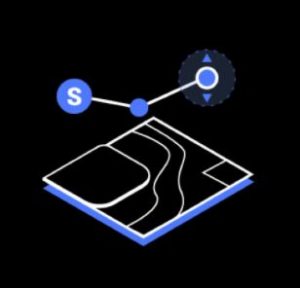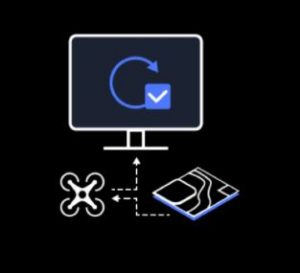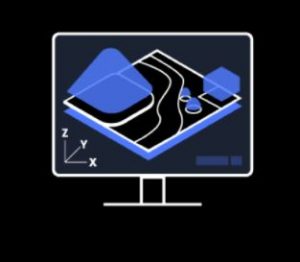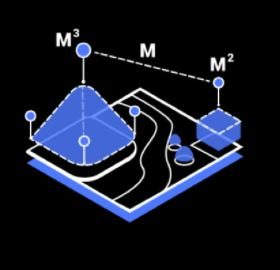
DJI Terra

Unparalleled efficiency and user experience
Import images with ease while navigating the intuitively designed interface effortlessly.
Bulk process up to 400 images/1 GB of RAM1, minimizing the wait time between field work and digital visualization.
Run reconstruction missions by employing multiple graphics cards simultaneously to improve efficiency.

Data Acquisition
Create efficient flight paths using predefined waypoint actions and adjustable parameters like altitude, speed, gimbal pitch angle, aircraft heading and more. For more complex and tight missions that require high attention to detail, use 3D Flight Visualization to design and simulate tasks on existing 3D models.

Meet and exceed your project standards
3D models with enhanced absolute accuracy by setting Ground Control Points (GCPs) and checkpoints, so you can measure and inspect with ease.
View a quality report of your mission to ensure the results meet your accuracy standards.

Compatibility and flexibility
Convert the coordinates of your maps and models into 8500+ major coordinate systems by simply selecting the output that fits your needs.
Incorporate POS data, GCPs, or both sets of data to create georeferenced maps and models with enhanced accuracy directly in the target coordinate system required by the project.
Product Information
Harness the power of AI-driven mapping solutions designed to take your industrial projects to the next level. Whether it’s object classification, site inspections and more, you can start developing task-specific mapping solutions to seamlessly carry out missions.
Data acquisition
Define mission objective, plan desired flight plan, and with a tap of a few buttons, autonomously collect critical data so you can achieve the required outcome.
Data Processing
Utilize refined image recognition technology to generate 2D and 3D data, resulting in a more realistic representation of your assets, objects, surroundings and more.
Data Application
Implement tools and machine learning techniques, which can be used across a variety of different industries – like classification algorithms for identifying trees, objects, and other scenarios.
Execution
Take the required action, and enjoy more efficient processes with machine control – be it automated crop spraying, monitoring work sites, transporting materials and more.
Capture, analyze and visualize your environment with DJI Terra – an easy to use mapping software developed to help industry professionals transform real-world scenarios into digital assets
Online Mode
Connect devices to the internet regularly to verify permissions and use paid features.
Offline Mode5
For users with high requirements for information security, paid features can be used without connecting devices to the internet.
Standalone Computation
Computations are done using one computer, fit for reconstructions with smaller datasets.
Cluster Computation
Multiple computers conduct computations simultaneously, significantly improving efficiency, fit for large-scale reconstructions.
Supports fully automated aerial triangulation cluster computation, and surveying level accuracy can be achieved without ground control points. 64GB of memory can handle 400,000 images.
| Feature/Version |
Agriculture
(Online Version) |
Pro
(Online and Offline Versions) |
Electricity
(Online Version) |
Cluster
(Offline Version) |
|---|---|---|---|---|
| Real-time 2D Mapping |  |
 |
 |
 |
| Agricultural application |  |
 |
 |
 |
| 2D Reconstruction (Field) |  |
 |
 |
 |
| 2D Multispectral Reconstruction |  |
 |
 |
 |
| 2D Reconstruction (Urban) |  |
 |
 |
|
| KML file import |  |
 |
 |
|
| Output Coordinate System |  |
 |
 |
|
| ROI Reconstruction |  |
 |
 |
|
| Image POS import |  |
 |
 |
|
| Multi-GPU Reconstruction |  |
 |
 |
|
| 3D Reconstruction |  |
 |
 |
|
| 3D Mission planning |  |
 |
 |
|
| Real-time 3D Mapping |  |
 |
 |
|
| GCPs |  |
 |
 |
|
| LiDAR Point Cloud Accuracy Optimization |  |
 |
 |
|
| Electricity Application |  |
 |
||
| Detailed Inspection |  |
 |
FAQ.
DJI Terra is a processing software that is compatible with any images captured from any UAS. It also processes data from the Zenmuse L1 & Zenmuse L2 Sensors.
All DJI Terra Licences can be purchased through Survey Drones Ireland. Just send an email to info@surveydrones.ie we will engage with you to get the correct licence for you.
DJI Terra Annual Subscription: Launch DJI Terra and log in to the DJI account that you used to purchase the subscription (or the DJI account that you entered and bound when completing the purchase). In the upper-right corner, click “User Center” > “Manage Licenses” and select the corresponding license, then click “Bind” to bind the license to the current computer.
DJI Modify Annual Subscription: Launch DJI Modify and log in to the DJI account that you used to purchase the subscription. In the upper-right corner, click “User Center” > “License Manager” and select the corresponding license, then click “Bind” to bind the license to the current computer.
DJI Terra and DJI Modify Annual Subscription: Bind the license in either DJI Terra or DJI Modify to activate both products simultaneously.
A Dedicated Laptop/Desktop as DJI Terra requires the licence to be binded to the device. You can Unbind it but you need to request this function through DJI Support. You can only unbind and rebind once during the licence activation time frame. The licence is not a floating licence.
DJI Terra and DJI Modify require Windows 10 or above systems (64-bit) with a minimum RAM of 32 GB and a NVIDIA graphics card with a compute capability of 6.1 or above and a GPU memory of 4 GB. A stable Internet connection is also required.
Yes.
For the offline version, once installed, all paid features operate without an internet connection.
For the online version, you must have an internet connection to login, however, you can continue to DJI Terra’s paid features offline without logging in again for up to 3 days.
Each subscription license can only be bound to one DJI account and one computer. Please make sure that you have installed both DJI Terra and DJI Modify on the same computer and logged in to the same DJI account. You can apply to unbind a device once every calendar year. To do so, please contact DJI Support.
It Will Not
No, the license is bound to the device’s hardware and therefore replacing hardware would invalidate the license.
